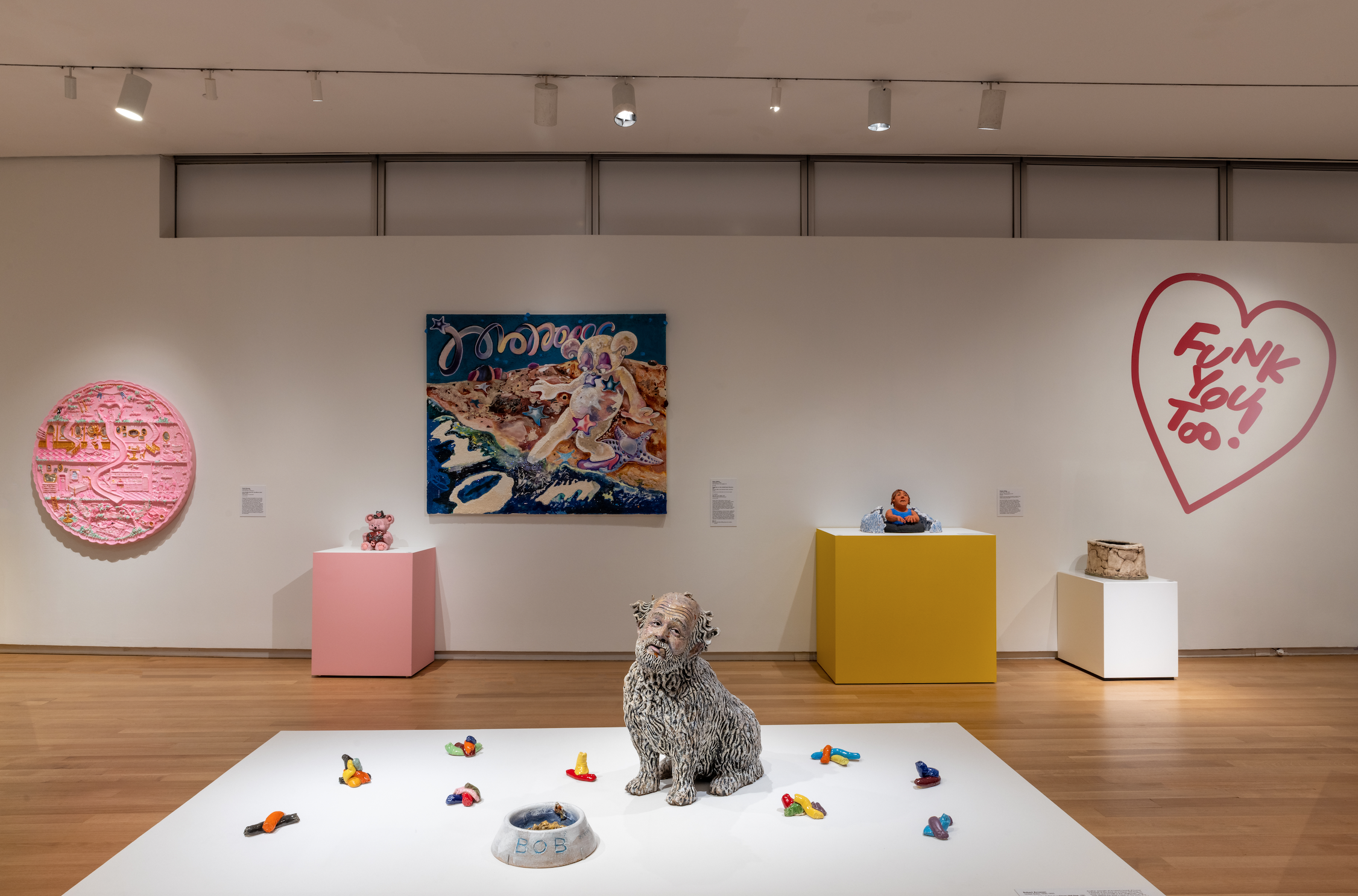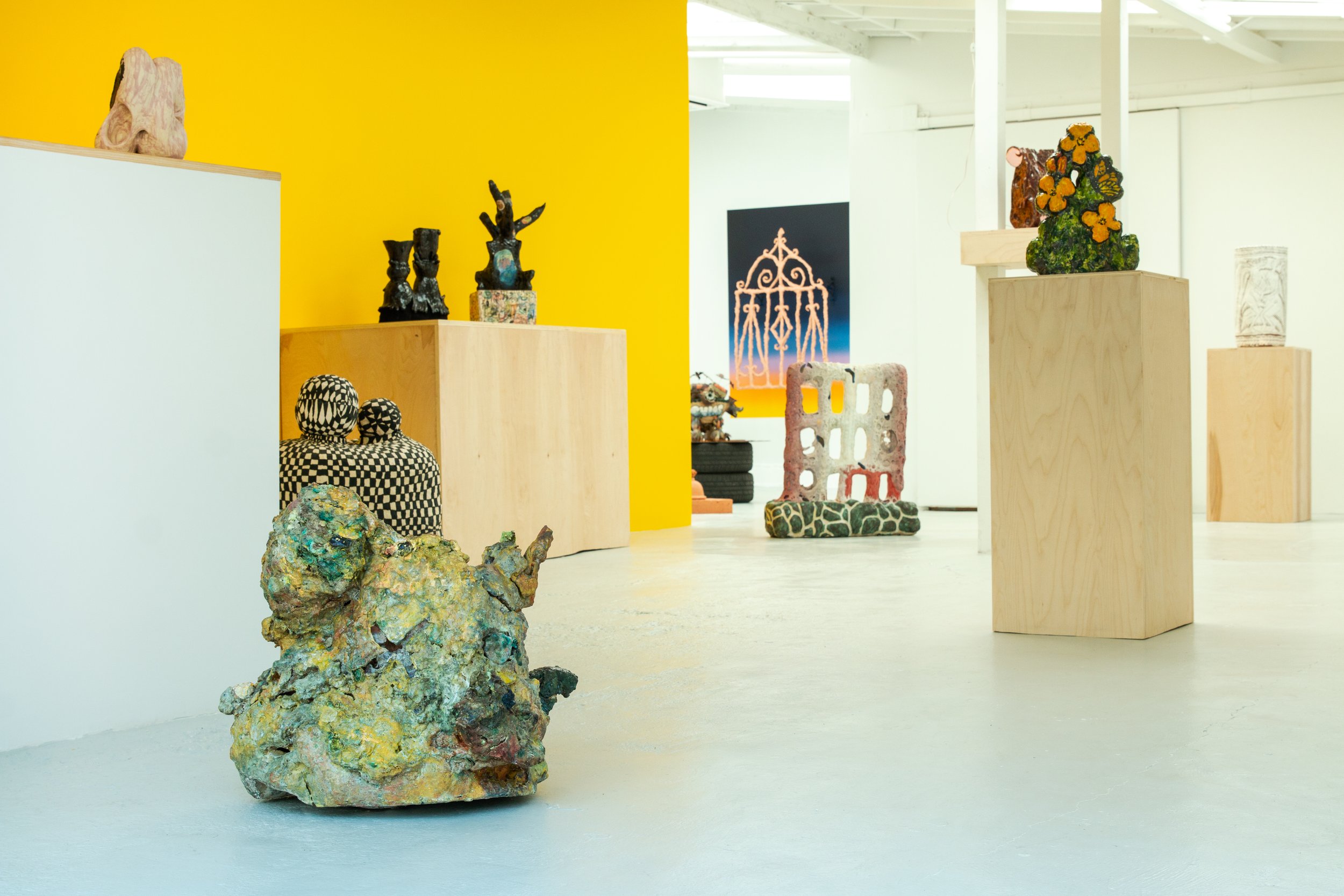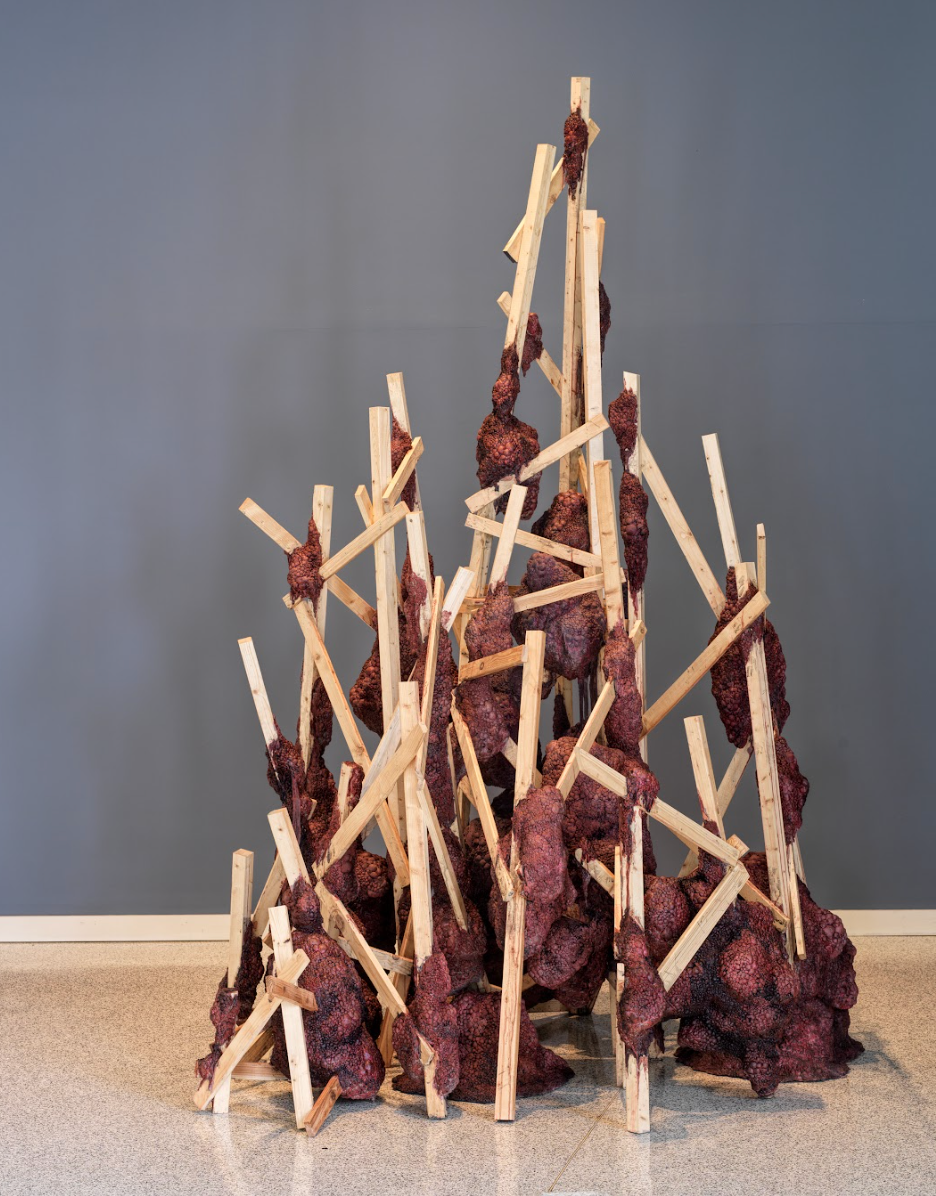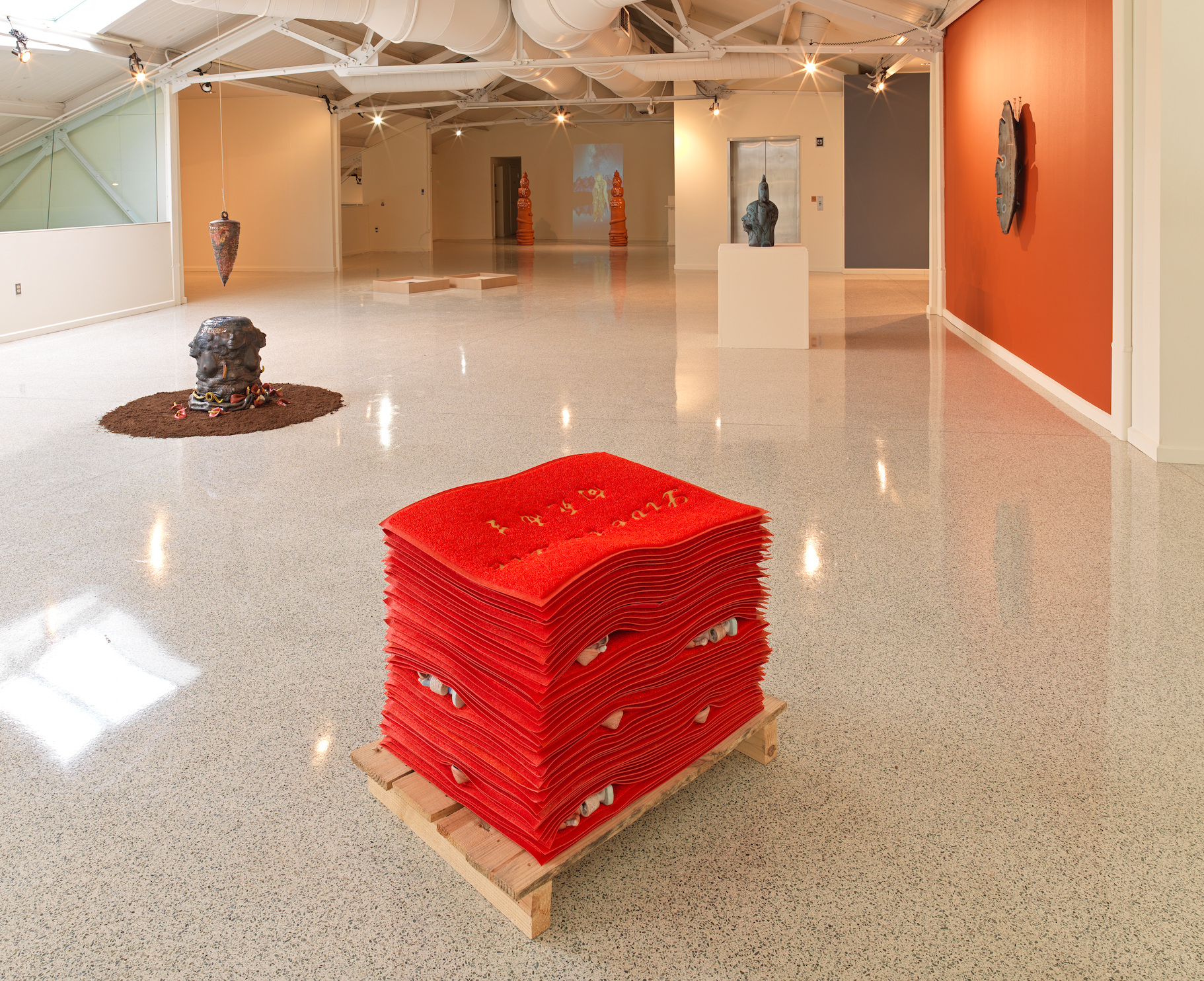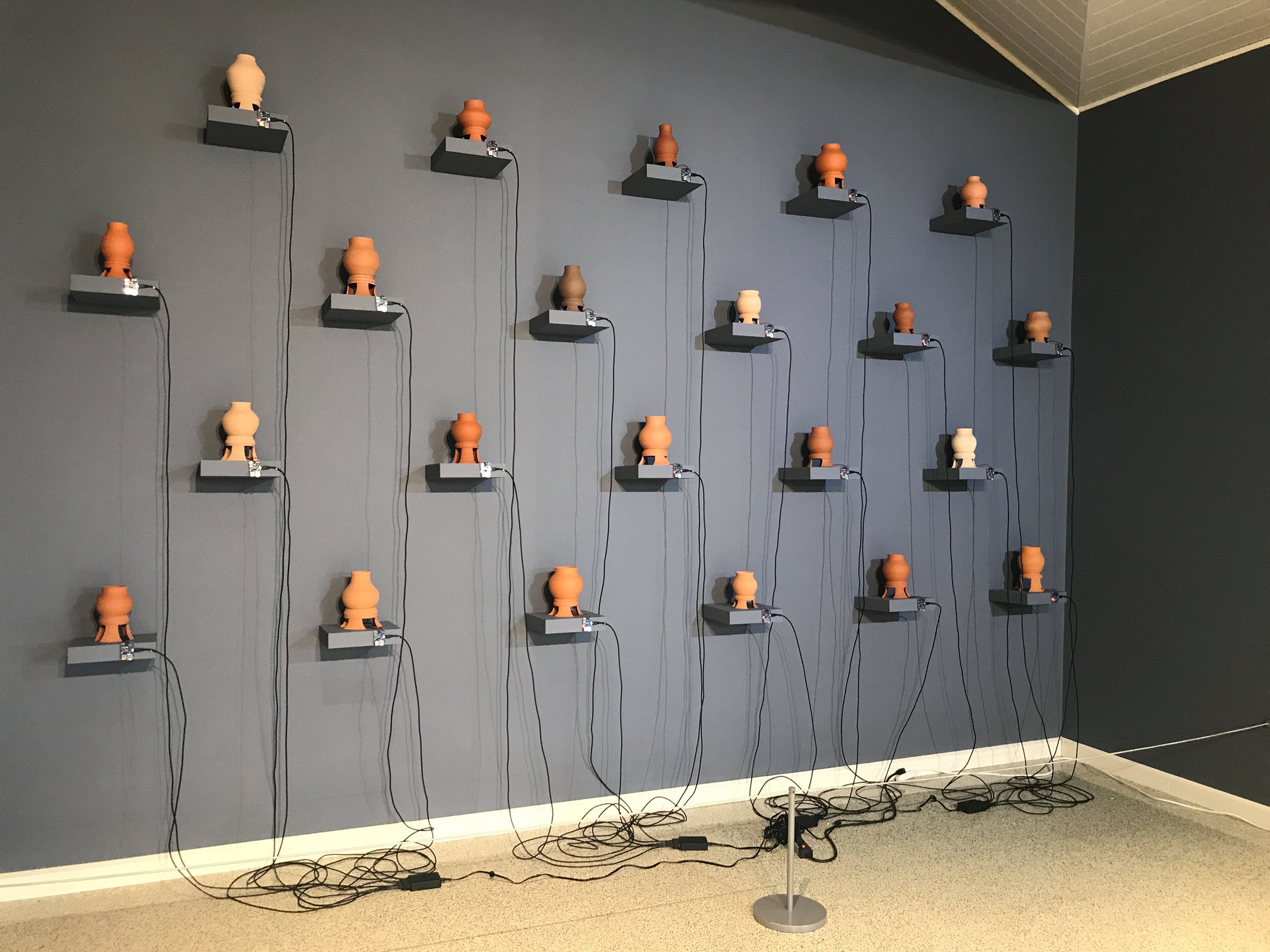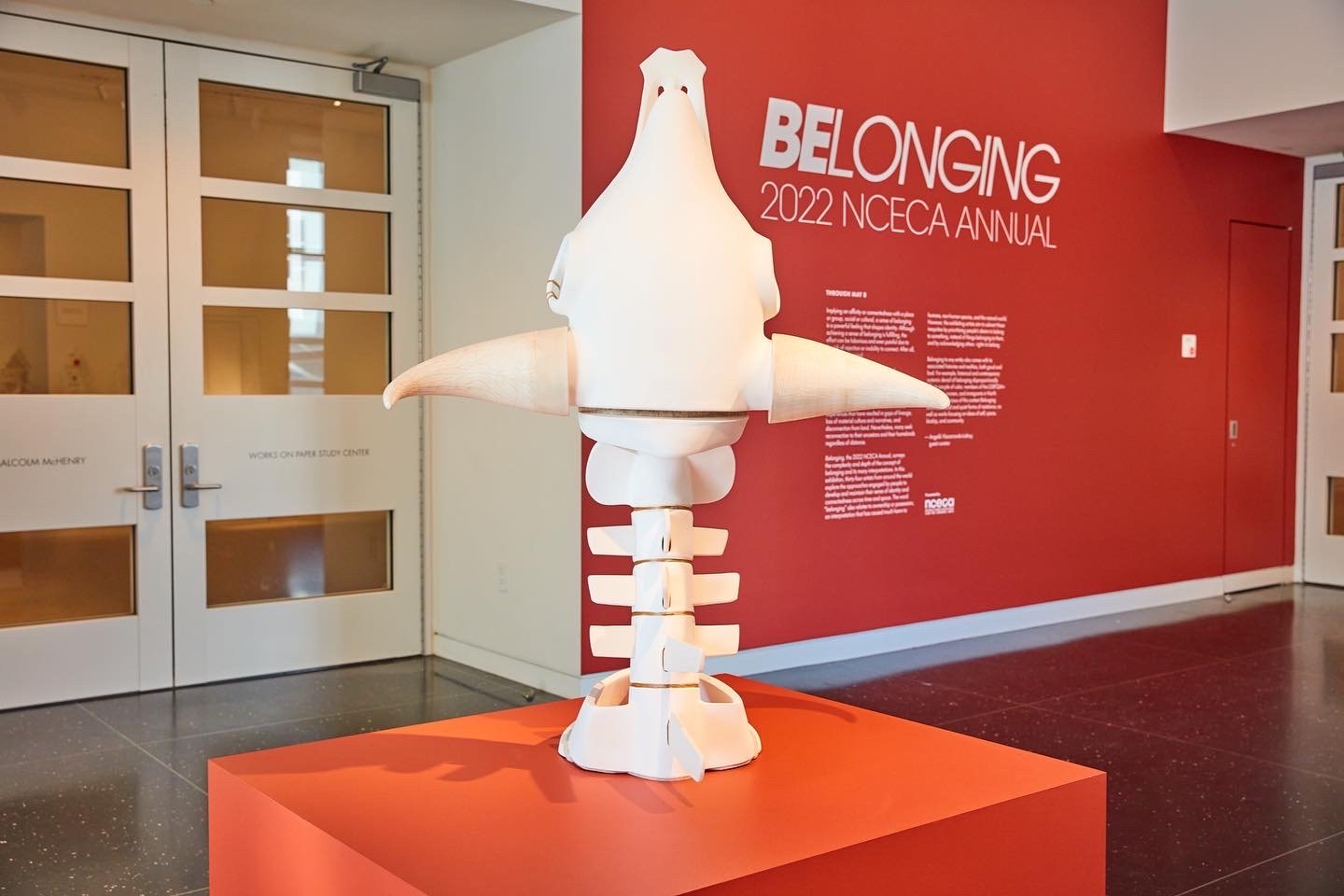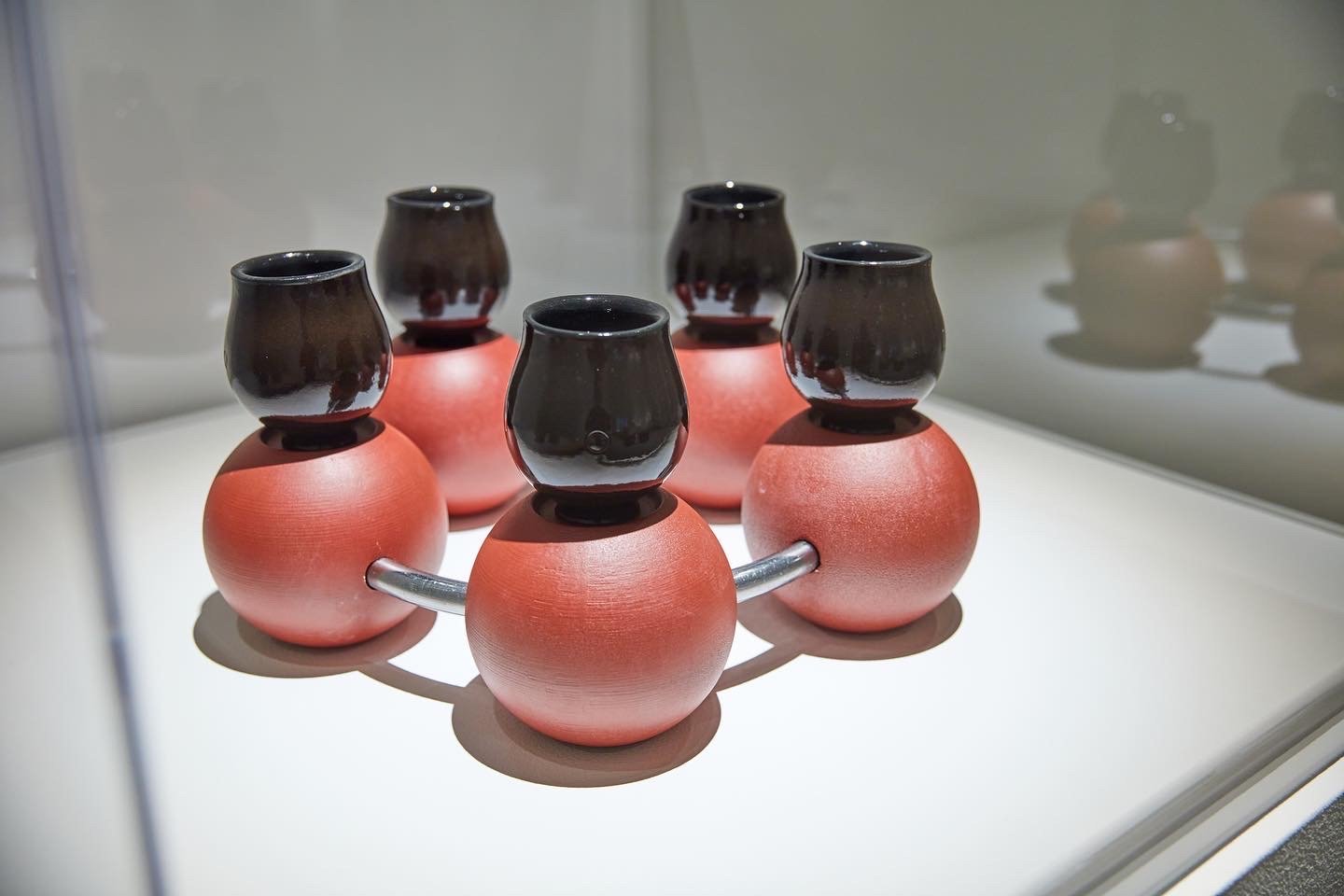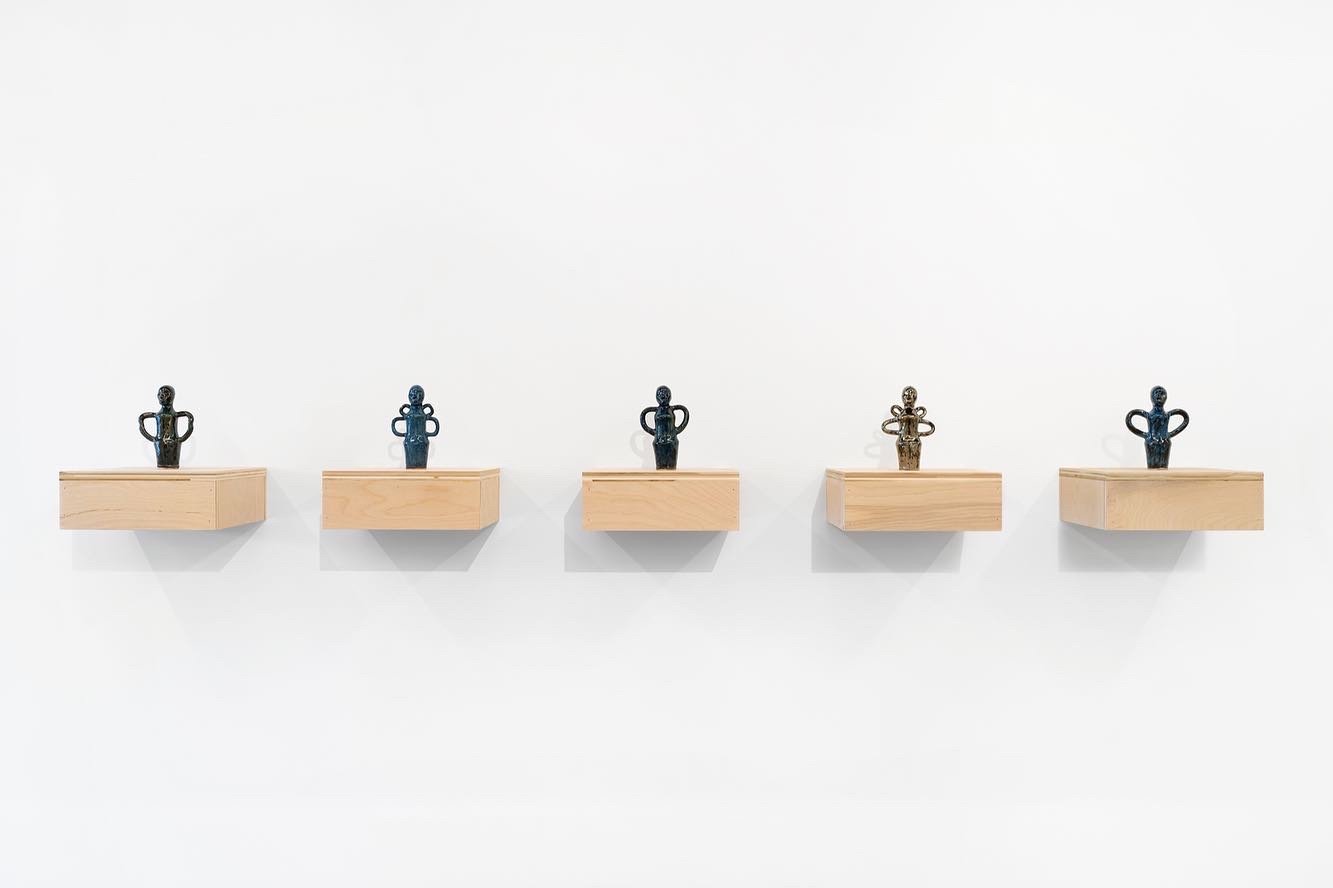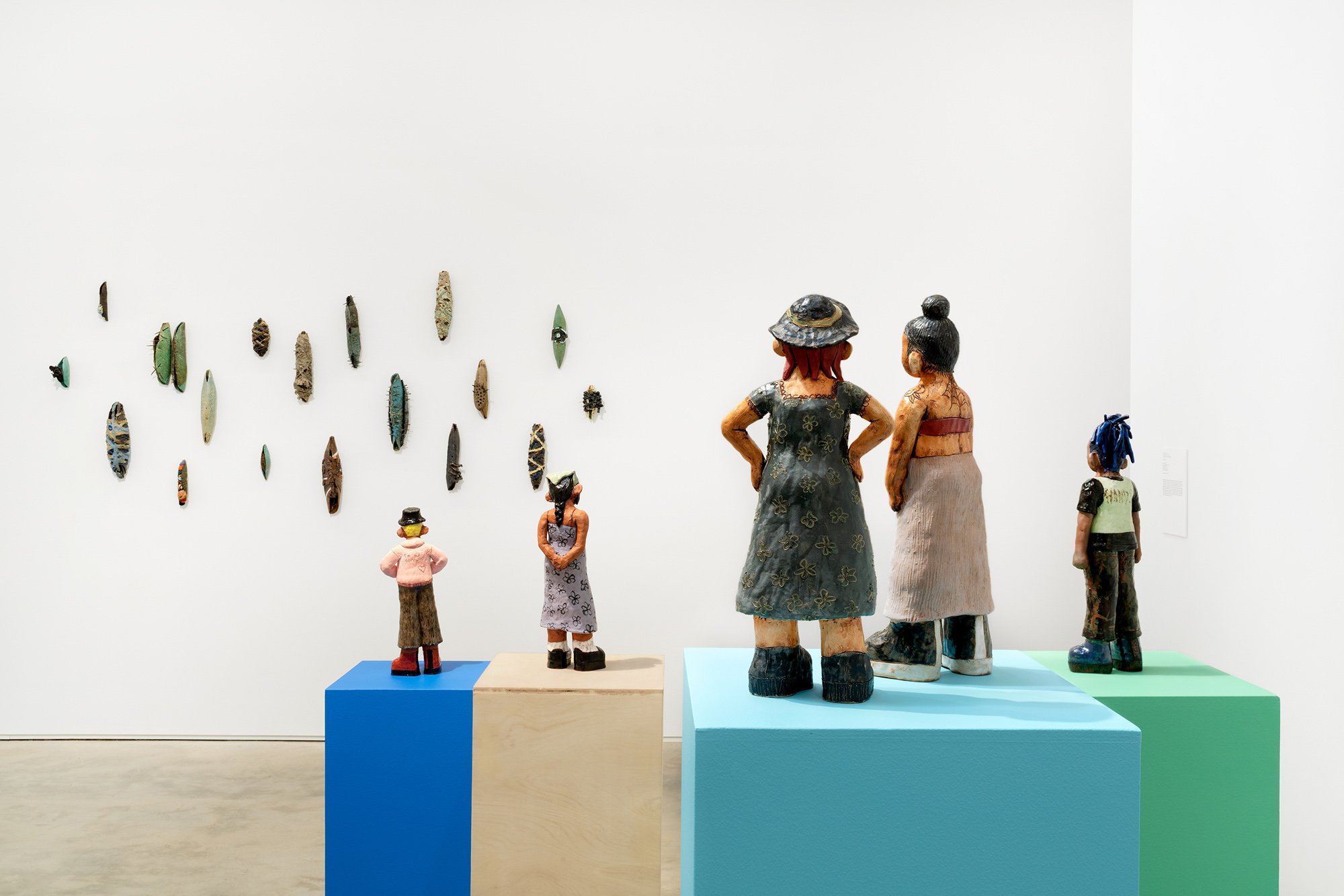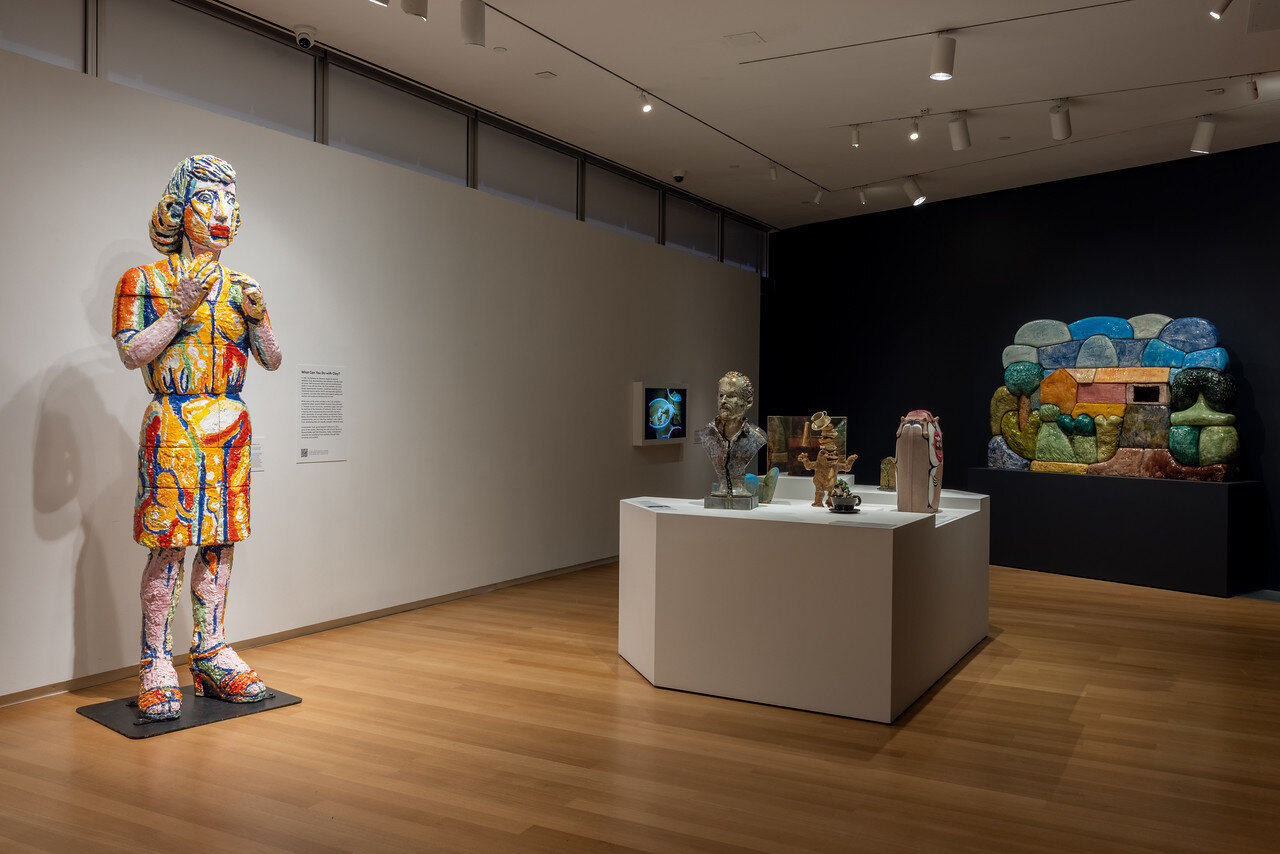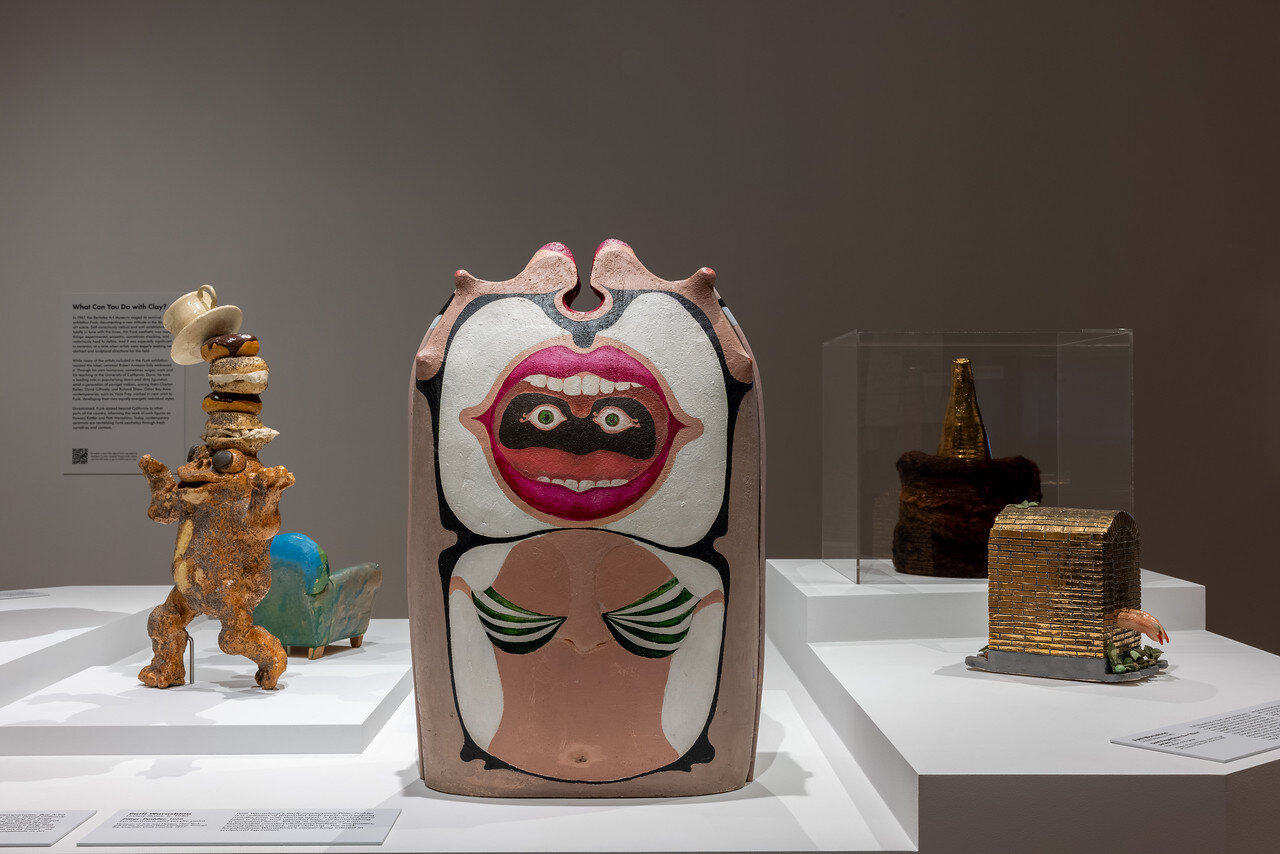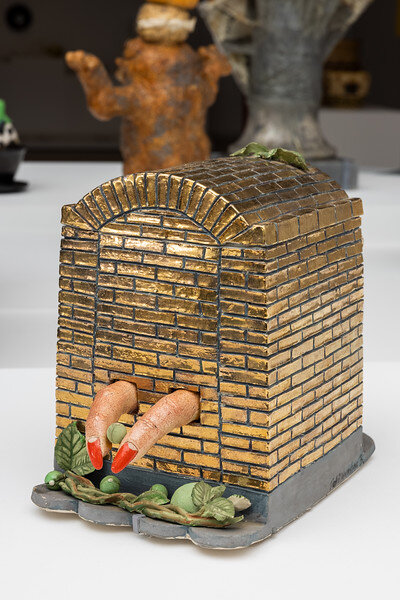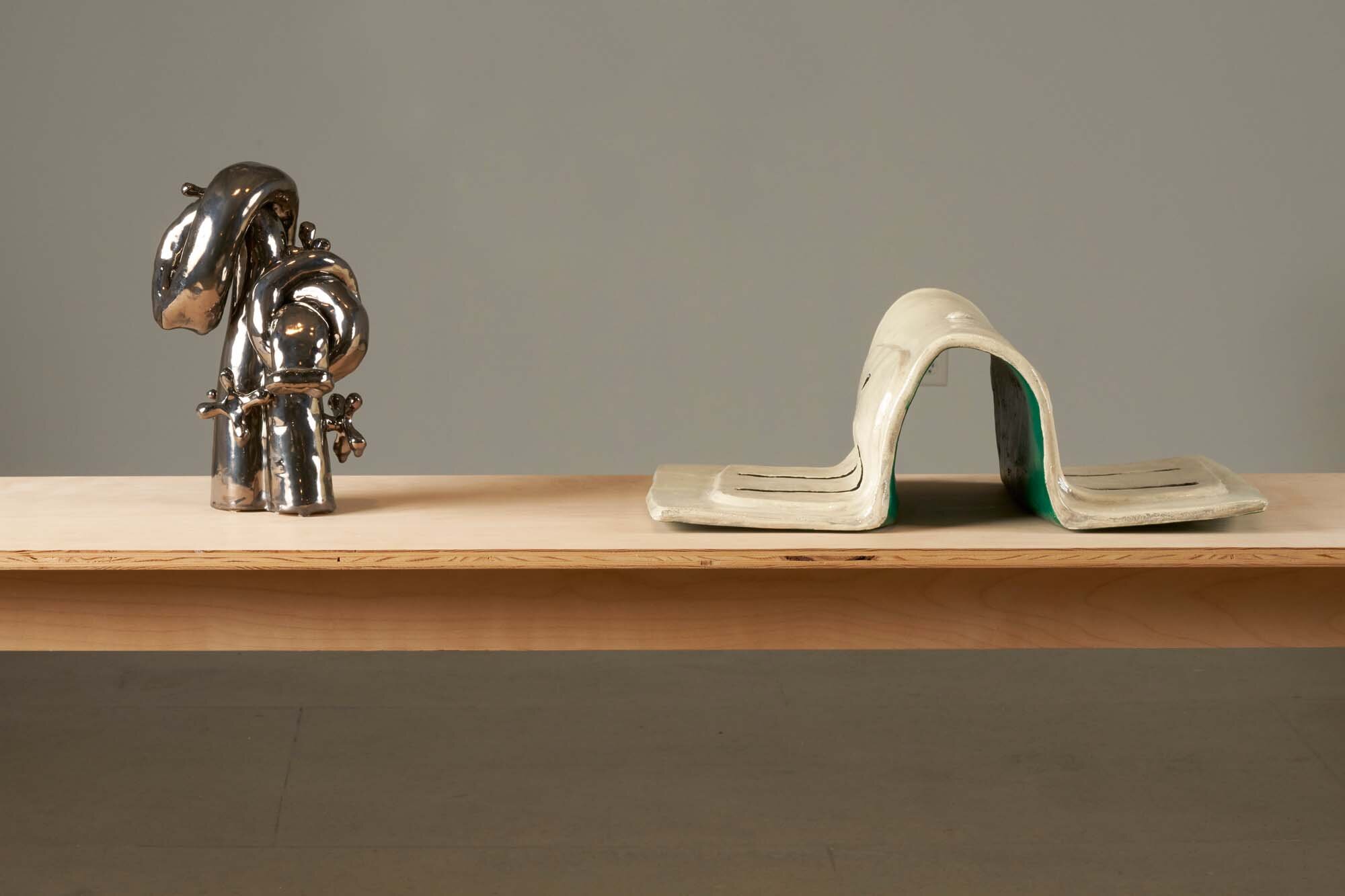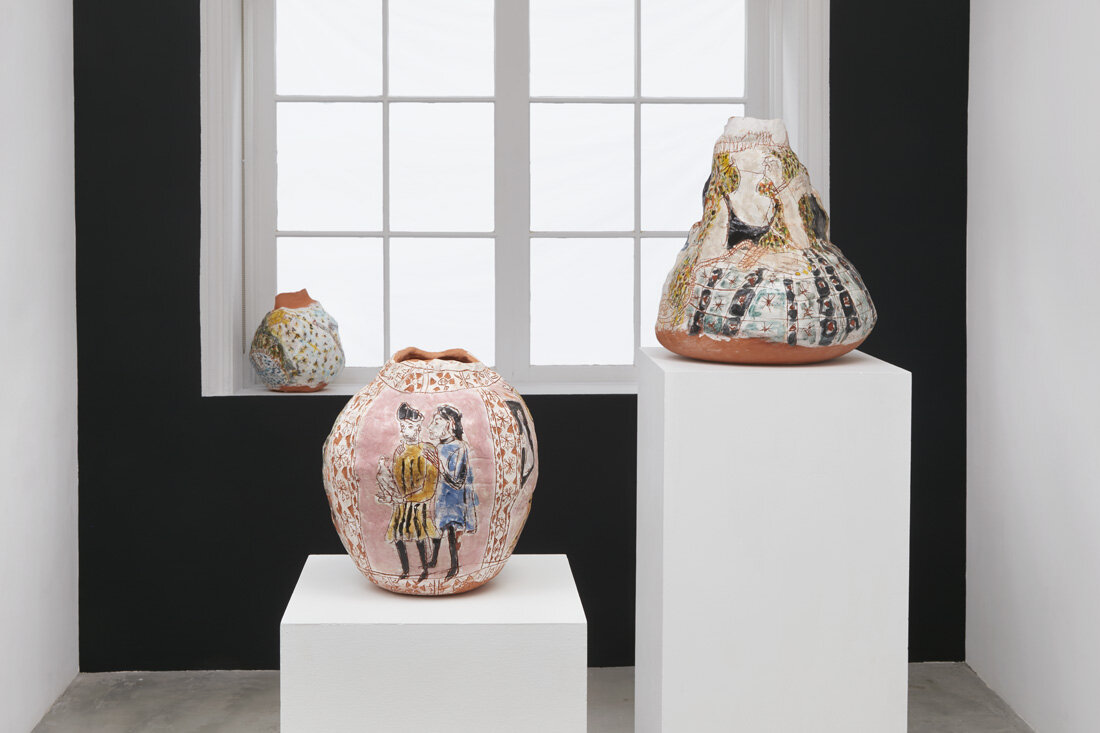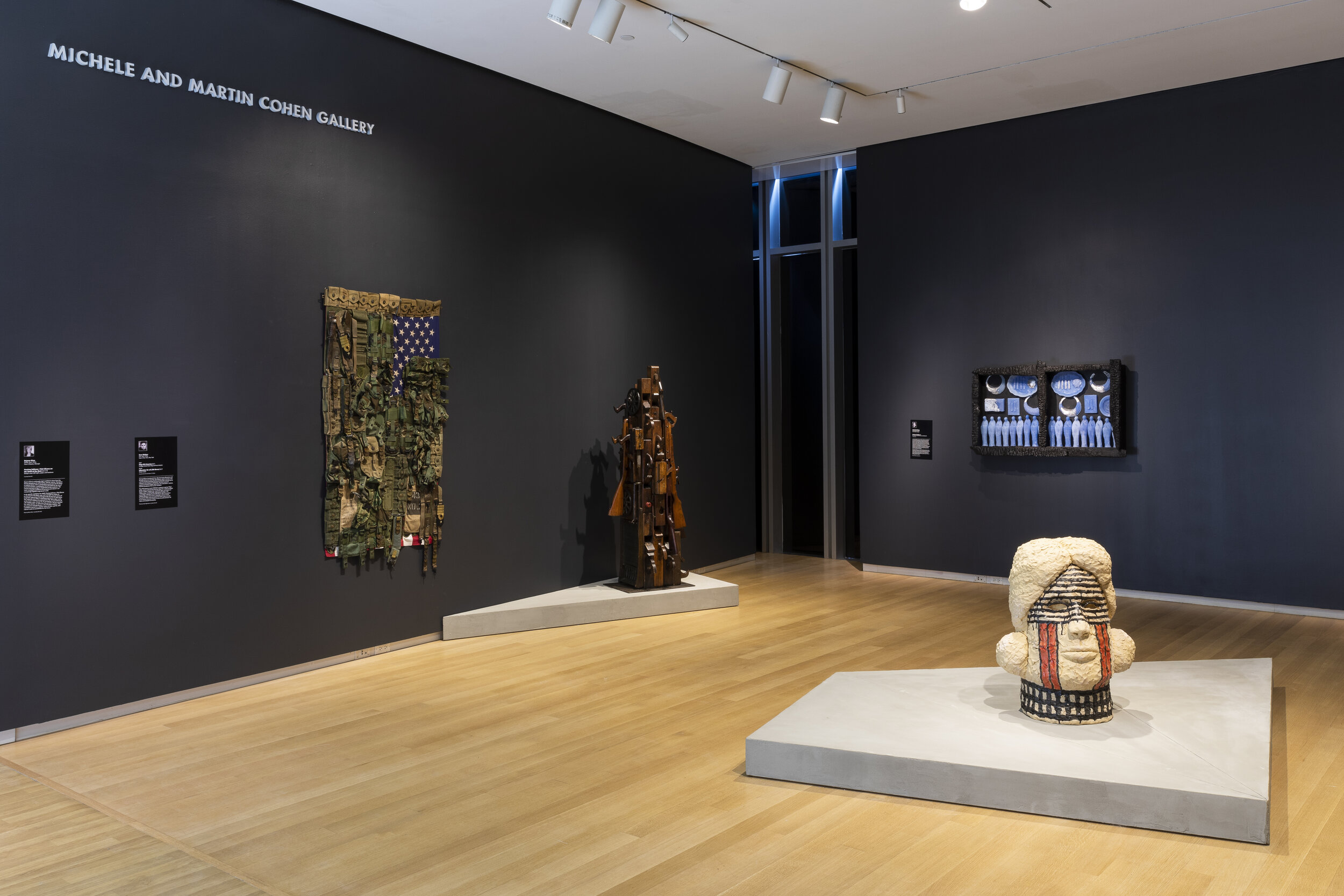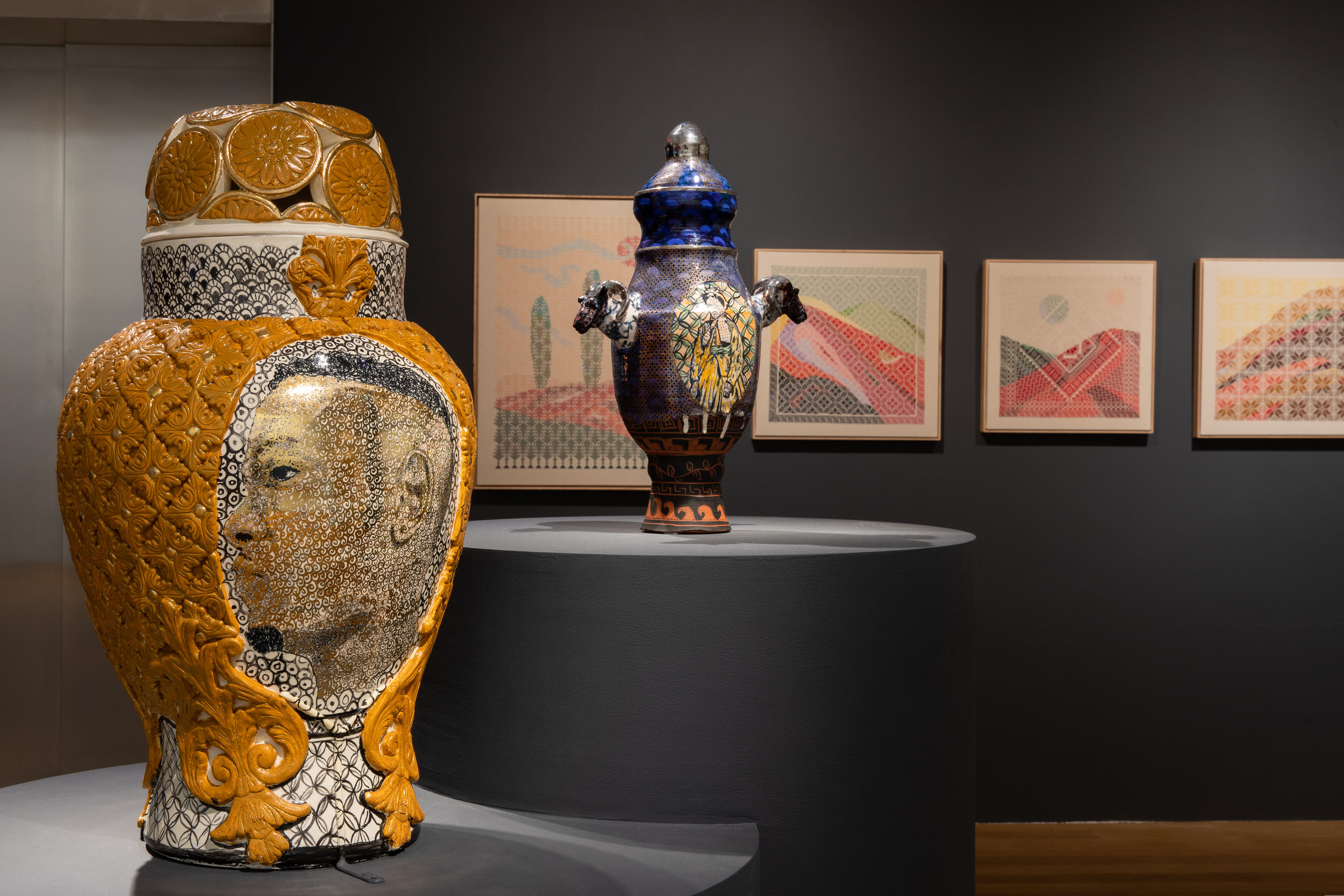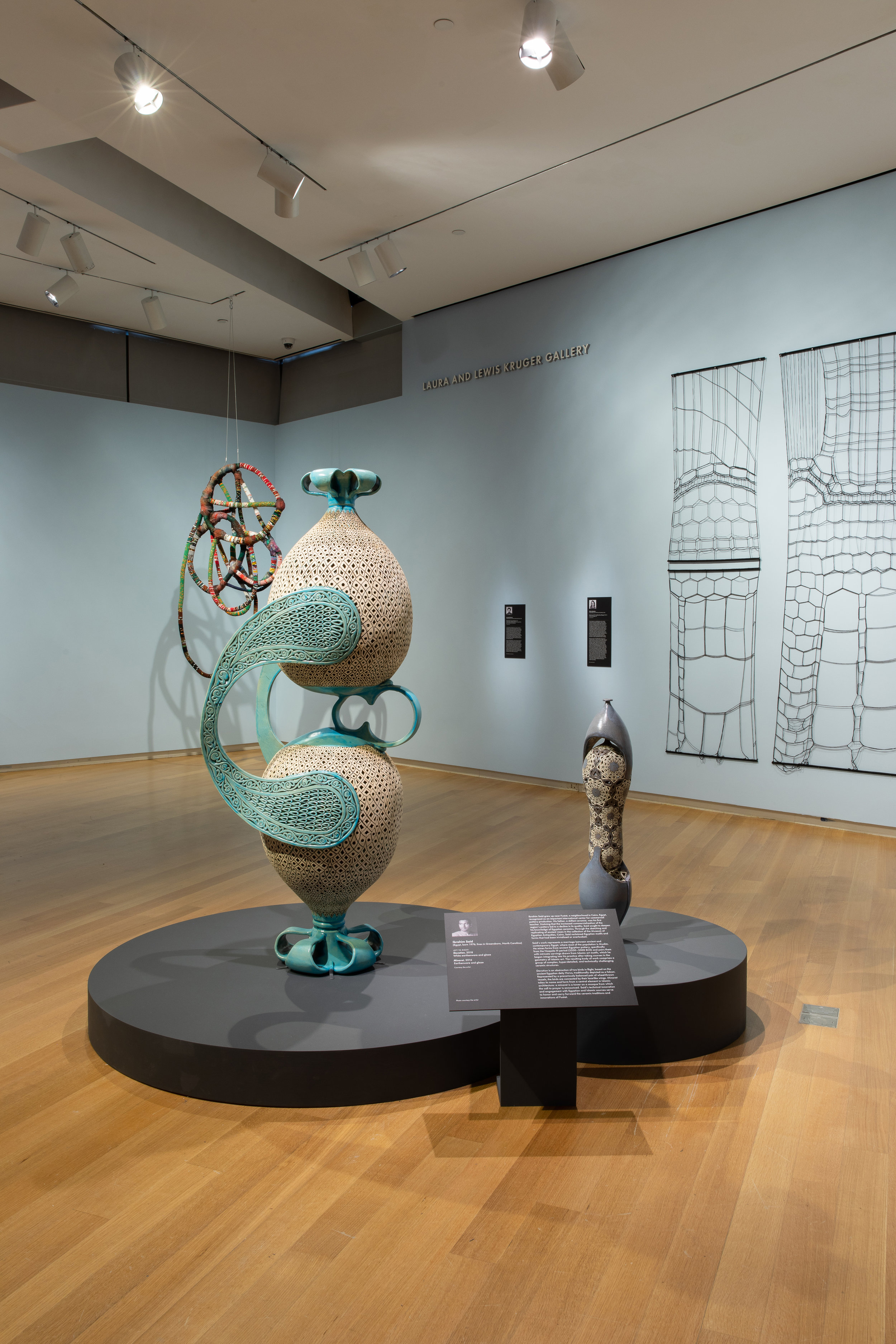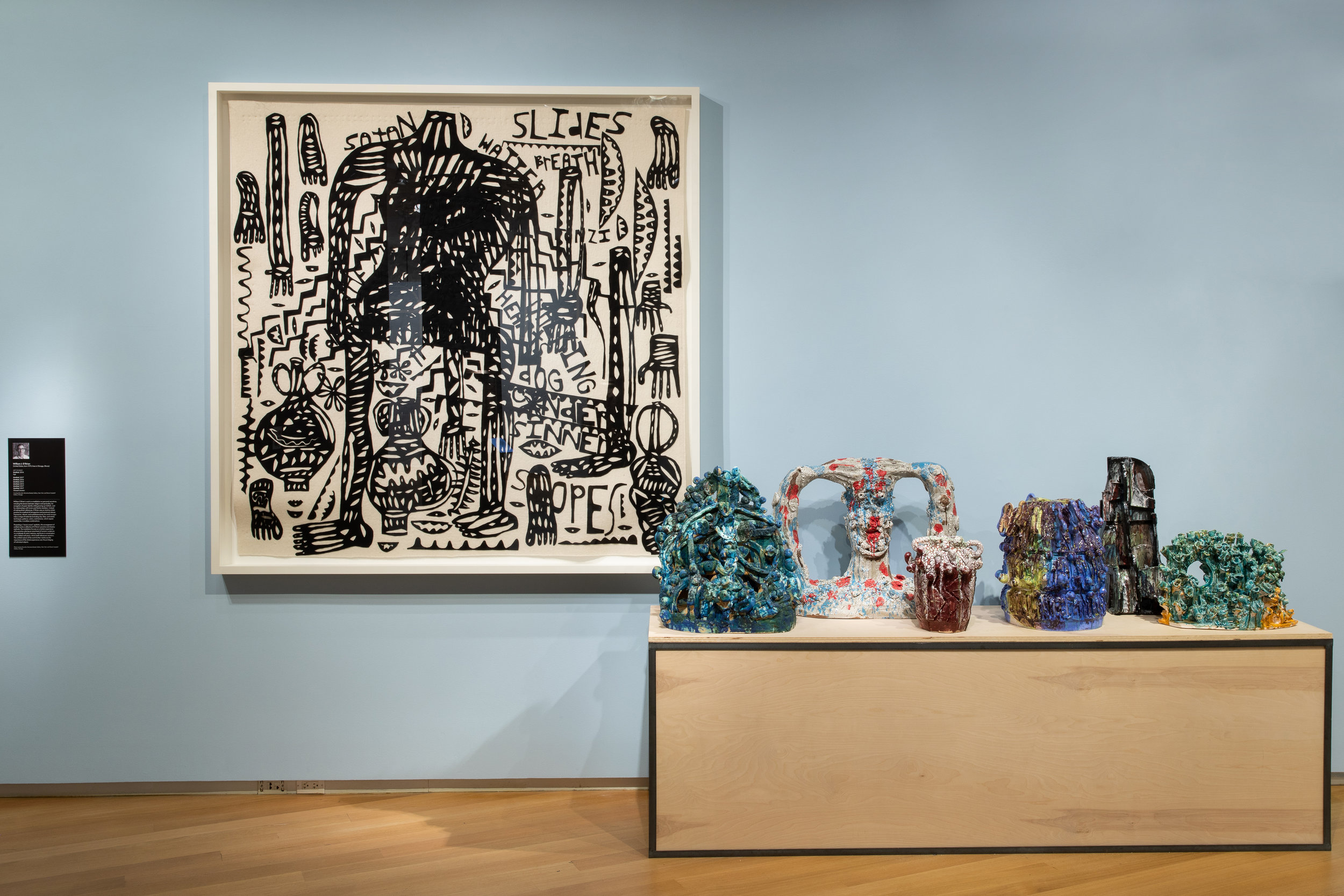Curatorial Highlights
Objects: USA 2024, 2024
Humans are uniquely devoted to the creation, reproduction, and reinvention of objects. We depend on them to fulfill our needs and desires. We want to possess and collect them. We care about what they look like and what they are made of. And most of all, we are invested in the motivation behind their creation and the personal, cultural, and political meanings imbued within them. These fundamental truths form the conceptual framework of Objects: USA 2024, a daring entry into the chronicles of objects made in the United States within the ever-blurring disciplines of art, craft, and design.
While it is impossible to capture the entire production of objects in this country with a finite number of examples, this exhibition surveys the practices of fifty-five artists, designers, and studios based in the USA. All redefine our perceptions of objecthood while tensioning subversion and affirmation, rearranging expectations of their chosen materials and formats, and questioning what it is an object gets to be.
Building on the legacy of the Objects: USA exhibitions (1969 and 2020) but with a twist, the participants of Objects: USA 2024 inhabit a spectrum of generative and fluid categories rather than more conventional medium or format-based sections, sequenced in the gallery as Truthsayers, Betatesters, Doomsdayers, Insiders, Mediators, Codebreakers, and Keepers; though any group could lead this circular spectrum. These archetypes are purposely active to provide invigorating routes to the intentions and concerns at the core of each maker’s practice.
Conscious of cultural and political contexts of creation, the artists and designers here craft objects as markers of identity, byproducts of environmental tension, beacons of tradition, odes to materiality and process, symbols of protest, containers of feeling, future relics, and so much more. These models of objecthood distill prominent approaches to contemporary making, revealing an infinite feedback loop of the psyche of our current moment and the hands that cannot remain idle.
Featured Artists: Nik Gelormino, Mary Lee Hu, Steven KP, Joyce J. Scott, Liam Lee, Georgina Treviño, Joyce Lin, Jolie Ngo, Vincent Pocsik, Layla Klinger, Mallory Weston, Brian Oakes, Myra Mimlitsch-Gray, Ryan Decker, Chen Chen & Kai Williams, MJ Tyson, Katie Stout, Nicki Green, Anne Libby, Dee Clements, Anina Major, Sulo Bee, Roberto Lugo, Pauline Shaw, Norman Teague, Carl D'Alvia, Linda Lopez, Trey Jones, Luam Melake, Misha Kahn, Collin Leitch, Jamie Bennet, Minjae Kim, Adam Grinovich, Ferne Jacobs, Matthew Szösz, Cammie Staros, Jordan Nassar, Nicole McLaughlin, Roxanne Jackson, Lilah Rose, Francesca Dimattio, Ian Collings, Jason McDonald, Coulter Fussell, Kim Mupangilaï, Wally Dion, Richard Chavez, Amia Yokoyama, Justin Favela, James Johnson, Venancio Aragon, Cedric Mitchell, Hugh Hayden, and Lonnie Vigil
Curated by Angelik Vizcarrondo-Laboy and Kellie Riggs for R & Company, NY
Installation photos by Logan Jackson, courtesy R & Company
SELECT PRESS
In Good Taste: Lindsey “Lou” Howard, 2023
In Good Taste, the first solo exhibition of New York-based artist Lindsey “Lou” Howard in Los Angeles, curated by Angelik Vizcarrondo-Laboy is part of the albertz benda’s on-going “Bathroom Series” and in this presentation, Howard acknowledges the space’s conventional function as a domestic bathroom with over a dozen sculptures investigating the cultural history of the toilet and its relationship to food consumption and waste through a critical lens. The show's title plays off scatological humor’s reputation as being “in bad taste.”
Fruits and vegetables will lay scattered around the black-tiled room, half-eaten, squished, or molding, revealing ominous skulls symbolizing the metamorphosis of food. This body of work continues Howard’s exploration into food capitalism and consumerism through subversive sculptures with a punk aesthetic that are as delectable as they are stomach-churning. The bathroom is integral to the food consumption cycle and the transformation of biological material. As waste flushes away – out of sight, out of mind – it appears to mark an ending, but sewage still has the potential to affect food production. Although many take access to proper and reliable plumbing and sewage processing for granted, Howard reflects on the effects of water pollution through sculptures of poisoned food waste intermingled with litter such as cigarettes, nails, and safety pins. The concept of the flush toilet is attributed to author and poet Sir John Harrington, godson of Queen Elizabeth, who published it in A New Discourse of A Stale Subject: A Metamorphosis of Ajax in 1596. Written while on banishment from the Queen’s court for his risque stories, this text, coded as a political allegory, targets the monarchy as the “excrement” of society. Howard’s punk approach echoes the anti-establishment attitude of Harrington’s writing. However, his designs did not improve the existing unsanitary conditions, and it took over 170 more years for someone to figure out the mechanics of the modern toilet and even longer to build sewage treatment facilities.
From an art historical context, the toilet has been the subject of many a provocateur. Marcel Duchamp’s infamous readymade Fountain (1917) is an iconic example that has inspired many others, from Sherry Levine’s Fountain (Buddha) (1977), a bronze homage to the former, to Maurizio Cattelan’s America (2018), an 18k gold toilet installed at the Guggenheim, New York, as a critique of the excess in the art market and a reminder of bathroom use as a shared human experience. Often left out of this narrative is Robert Arnesons’s self-deprecating series of ceramic toilets from the 1960s, positing the commode as “the ultimate ceramic” by exploiting the scatological aesthetics of clay. Howard continues this art historical exploration of toilets and bathroom humor as a form of cultural and political protest by intervening with the toilet of albertz benda’s gallery. She cooks up a nightmare BBQ of rotten meat and double-headed fish over the sink and the toilet, heightening the absurdity of the environment. A fiery grill over the mouth of the porcelain bowl makes for a “hot seat” referencing Sir John Harrington’s penchant for getting in trouble. Although displaying food within the context of a bathroom sounds like a distasteful scene, caught within the tension of attraction and repulsion, Howard’s enigmatic sculptures make it impossible to look away.
Curated by Angelik Vizcarrondo-Laboy for albertz benda, LA
Install photos courtesy albertz benda
Funk You Too! Humor and Irreverence in Ceramic Sculpture, 2023
Funk You Too!: Humor and Irreverence in Ceramic Sculpture arrives at a moment when clay has unprecedented currency in the art world as a sculptural medium. Bringing together over fifty historical and contemporary works, this exhibition contextualizes today’s ceramic practice in relation to 1960s and 1970s West Coast Funk ceramics and their makers, particularly their use of humor as a tool of critique and personal expression. In a mashup of past and present, pieces are placed in dialogue to draw out aesthetic and conceptual parallels.
Artists associated with West Coast Funk ceramics adopted an innovative approach to the medium through satire, irreverence, and irony, among other forms of humor. In the decades since the emergence of Funk art in the1960s, clay has developed as a vehicle for amusing storytelling and a sensitive register for addressing political, social, and aesthetic concerns—a testament to how the radical shift effected by Funk artists’ avant-garde production created space for others to use subversive tactics in clay. While conscious of their predecessors, the contemporary artists in this exhibition re-examine the potential for humor in clay through a rainbow of perspectives, forming the basis for an expanded exploration of narratives that go beyond historical precedent. In this way, the new guard spotlighted here carries Funk into the future, reinvigorating the use of a good joke as a lens to address some of the most pressing social and political issues of our day.
Robert Arneson, Clayton Bailey, Viola Frey, David Gilhooly, Howard Kottler, Maija Peeples-Bright, Sandra Shannonhouse, Richard Shaw, Chris Unterseher, Peter VandenBerge, Patti Warashina, Melvino Garretti, Sally Saul, and Magdalena Suarez Frimkess constitute the earlier generation of artists working in the spirit of Funk. The newer cohort is represented by Diana Yesenia Alvarado, Alex Anderson, Natalia Arbelaez, Genesis Belanger, Sharif Farrag, Salvador Jiménez-Flores, Yvette Mayorga, Ruby Neri, Woody De Othello, Didi Rojas, Alake Shilling, and Maryam Yousif.
Curated by Angelik Vizcarrondo-Laboy for the Museum of Arts and Design, NY
Installation photos by Jenna Bascom, courtesy MAD Museum
SELECT PRESS
Barro Barrio, 2023
Barro Barrio marks GGLA’s third exhibition at 3407 Verdugo Road, a convening of 25 Los Angeles-based ceramicists. Spanish for “Clay Neighborhood,” Barro Barrio celebrates LA as the heart of a thriving community of artists engaging with the medium of clay. It recognizes clay as a material with a deep-rooted history in this expansive city that continues to be critical for local artistic production and innovation. While the work presented constitutes a wide range of themes and aesthetics, together, they are suspended in tension between playful abandon and dystopian anxiety, much like LA itself.
LA has long been a town that embraced clay, pushing and expanding our sense of what is possible within this humble medium. With a litany of storied ceramic programs and a long lineage of makers from various disciplines, it is no surprise that the city remains a potent hotbed for making, especially given ceramics’ recent rise to the spotlight as a sculptural conduit. While the pristine finishes and smooth glossy surfaces of the “LA Look” in the 1960s became a trademark for the area, local ceramicists have gone against this aesthetic for decades, creating heavily textured and visceral work. A defining quality that has inevitably continued with the artists of Barro Barrio. Many participating artists also make work that defies the medium’s utilitarian connotations through an irreverent approach to functionality, value, and subject matter by engaging in strategies of absurdity and humor.
While this exhibition demonstrates that LA’s booming ceramic scene is pulsing with energy, it is only a glimpse at the extensive network of artists working with clay locally. Abstract and figurative, large and small, functional and sculptural, all co-exist to create an ecosystem within GGLA’s walls that reflect the richness of LA cultural production. Barro Barrio is a celebration of here and now.
Featured artists: Anabel Juárez, Nicki Green, Alex Anderson, Brittany Mojo, Joshua Miller, Amelia Lockwood, Willy Reed, Lizette Hernandez, Josh Cloud, Karla Ekatherine Canseco, Jane Orr, Ryan Flores, Claudia V. Solórzano, Alex Kerr, Charles Snowden, Kim Kyne, Caroline David, Lauren Elder, Monica Noonan, Jackie Rines, Maddy Inez Leeser, Zachary Maxfield Benson, Chris Miller, Kristen Morgin & Jasmine Little
Organized by GGLA and co-curator Angelik Vizcarrondo-Laboy
Installation photos courtesy GGLA
Fragile: Earth, 2022—23
Fragile: Earth presents artwork reflecting the social, environmental, and personal perceptions on fragility of sixteen artists through the unique materiality of clay. Metaphorically, clay perfectly embodies the duality of fragility. When wet, it is sensitive, malleable, and forgiving. After firing becomes rigid and sturdy, however, it can easily shatter. The alchemy of ceramics metaphorically demonstrates the nuanced relationship between vulnerability and strength, a through-line of exploration in this exhibition. While clay is predominant in this exhibition, other mediums such as textile, metal, wood, and video expand the artists’ narratives.
Consideration of the concept of fragility reveals the anxiety of potential rupture, failure, and dissolution. A tension between the fear of vulnerability and the labor of preventing collapse. Many things taken for granted by humanity are of fragile, even ephemeral, composition. History, connection, belonging, memory, nature, and communication, among many others, can easily be lost without stewardship. This notion is particularly relevant to this cohort, made of artists of color, who often live within fragmented histories and realities due to the lasting effects of colonialism.
Fragile: Earth investigates the power of vulnerability, the frailty of a strong facade, and the precarity of entities such as the climate, government, and life itself amid ongoing global health, social, and environmental crises. The exhibiting artists underscore the fallacy of the oppositional perception between fragility and strength. They argue for the inherent strength in vulnerability, which allows for honesty and connection, while structures and systems believed to be strong are often full of cracks.
Many of the objects in this exhibition arrived at Grounds for Sculpture carefully packaged and labeled “Fragile.” Bold, red letters warning of the delicate nature of the cargo, a plea for care and tenderness. These artists embrace fragility as a natural part of life. They propose recognizing fragility as a call to mend, protect, and nurture that which is precarious. Instead of prioritizing impeccable wholeness, this exhibition embraces the process of carefully putting back together what is broken or needs dismantling differently as a form of resilience.
Featured artists: Anina Major, Natalia Arbelaez, Salvador Jimenez-Flores, Adam Chau, Anabel Juarez, Jane Margarette, Syd Carpenter, Virgil Ortiz, April D. Felipe, Magdolene Dykstra, Mariana Ramos Ortiz, Ashwini Bhat, Jennifer Ling Datchuck, Sara Wise, Ebitenyefa Baralaye, & Raheleh Filsoofi
Organized by The Color Network (TCN) and guest-curated by Angelik Vizcarrondo-Laboy. The Color Network is an artist-run organization with the mission of aiding the advancement of people of color in the ceramic arts. Seven artists were selected by TCN, while five were selected by the guest curator, along with four artists from an open call.
Installation photos by Bruce White, courtesy Grounds for Sculpture
SELECT PRESS
Belonging: The 2022 NCECA Annual, 2022
Implying an affinity or connectedness with a place or group, social or cultural, a sense of belonging is a powerful feeling that shapes identity. Although achieving a sense of belonging is fulfilling, the effort can be laborious and even painful due to the risk of rejection or inability to connect. After all, belonging is survival.
Belonging also strongly signifies spatial relationships. From navigating new territories to remaining rooted to formative places long vacated, the quest for belonging can evoke nostalgia and dissonance. For millions, a sense of belonging is profoundly affected by patriarchal, colonialist experiences that have resulted in gaps of lineage, loss of material culture and narratives, and disconnection from land. Nevertheless, many seek reconnection to their ancestors and their homelands regardless of distance.
Belonging: The 2022 NCECA Annual surveys the complexity and depth of the concept of belonging and its many interpretations. In this exhibition, thirty-four artists from around the world explore the approaches engaged by people to develop and maintain their sense of identity and connectedness across time and space. The word “belonging” also relates to ownership or possession, an interpretation that has caused much harm to humans, non-human species, and the natural world. However, the exhibiting artists aim to subvert these inequities by prioritizing people’s desire to belong to something, instead of things belonging to them, and by acknowledging others’ right to belong.
Belonging to any entity also comes with its associated histories and realities, both good and bad. For example, historical and contemporary systemic denial of belonging disproportionally affects people of color, members of the LGBTQIA+ community, women, and immigrants in North America. Conscious of this context, Belonging showcases bold and quiet forms of resistance, as well as work focusing on ideas of self, space, kinship, and community.
Featured artists: Alex Anderson, Cannupa Hanska Luger, Salvador Jimenez Flores, Ashwini Bhat, Habiba El-Sayed, George Rodriguez, Natalia Arbelaez, Deshun Peoples, Lydia Thompson, Patsy Cox, Japheth Asiedu-Kwarteng, Horacio Casillas, Adam Chau, Jessika Edgar, Nazare Feliciano, Jasmine Fetterman, Raheleh Filsoofi, Eleanor Foy, Alina Hayes, Kevin Kao, Clay Leonard, Cindy Leung, Linda Lopez, Janina Myronowa, Kelly O'Briant, Danielle O'Malley, Aimee Papazian, Patricia Sannit, Joshua Schutz, RJ Sturgess, Phyllis Kudder Sullivan, Daniel Alejandro Trejo, Amythest Warrington, and Kathy Yoshihara
Curated by Angelik Vizcarrondo-Laboy for NCECA, hosted by the Crocker Art Museum, CA
Installation photos by Abner Soto, courtesy NCECA
The Universe Within, 2022
The Universe Within is not a definitive statement on who women-identifying and non-binary people of the Black diaspora are. Instead, it is a space that recognizes their limitless potential to be. Layered, dynamic, complex, nuanced, ever-evolving. A multitude of selves within the vessel of their bodies. Like our universe, mysterious and mystical, their interiority is rich and vast. This exhibition is a privileged glimpse into the wondrous multiformity within the spectrum of Black femininity and queerness.
Extending over three rooms, eleven artists take up space, an understated form of resistance. Recurrent themes surveyed in the exhibition include the relationship between self and place, nurturing individual and collective identity, transformation, celebration, survival, ancestral lineages, navigating the problematic expectations and violence imposed on their bodies, and the importance of reclaiming childhood.
The artists of The Universe Within use clay as their primary vehicle for storytelling. An ancient and elemental medium, long marginalized in the art world. Parallelly, the field of studio ceramics has notoriously underrepresented Black artists for decades, especially those who are women-identifying and non-binary. However, the sculptures and vessels, both abstract and figurative, created by the artists of The Universe Within demonstrate that clay—which is capable of impressive transfiguration—is an effective tool for empowering their narratives in their quest for liberation, connection, and beauty.
Featured artists: Malene Barnett, Maya Beverly, Shea Burke, Sydnie Jimenez, Anina Major, Sana Musasama, Sharon Norwood, Lola Ayisha Ogbara, Lydia C. Thompson, Maya Vivas & Patrice Renee Washington
Curated by Angelik Vizcarrondo-Laboy for Mindy Solomon Gallery, FL
Installation photos by Zachary Balber, courtesy Mindy Solomon Gallery, FL
Out of Office, 2021
The circumstances of the past year and a half required the world to slow down. In a capitalist society, the shift in pace caused much anxiety and hardship, despite allowing a momentary collective breather. Leisure, defined as “freedom provided by the cessation of activities,” has historically been a luxury reserved for the upper echelons of society, from aristocrats to the rich and famous. Without proper boundaries in place, working from home busted the myth of work-life balance by tipping the scales further towards work.
The “grind culture,” which conflates productivity with self-worth, conditions us to understand leisure as a hard-earned and rare reward. However, more and more cultural thinkers and organizations are working to dismantle the inherently problematic work culture in the United States by underscoring the importance of regular leisure and self-care. Besides their health benefits, centralizing joy, pleasure, and healing is a tool of resistance and protest against oppressive systems, especially for people of color and other marginalized communities. How can intentional and normalized hedonism help upend the work-life balance heavily dictated by the intersection of race, class, and gender?
Historically, art is intertwined with leisure. The reclining nude, for example, one of art’s most popular tropes, is inherently leisurely. How are contemporary artists recontextualizing the genre? What other activities, subjects, and materials embody the pursuit of happiness, play, pleasure, and rest in art? How can leisure improve our relationship with ourselves, those close to us, and with our communities? What are the subtle and intimate ways in which we prioritize living—loving, dancing, sleeping, exercising, eating, healing, and other leisurely actions—above working?
Featured artists: Jackie Zysk, Echo Goff, Padyn Humble, Lydia Kern, Phoebe Rotter, Carrie Curley- Lue, Anna Wehrwein, Chad Kouri, Raina Briggs, Graham Krenz, Virginia Broersma, Natasha Brennan, Julia Terry, Xinan Ran, Grace Stott, Ashley Estabrook, Gal Cohen, Robin Adsit, Jezabeth Gonzalez, Corrine Yonce, Lydia See, Kayleigh Farley, Sarah Sudhoff, Katharine Umsted, Nina Bellucci, Morgan Rose Free, Christina Massey, Kim Tateo, Julia Rooney, Stella Ebner, Melissa Sclafani, Liz Jones, Morgane Richer La Fleche, Dani Lopez, Dana Wood Zinsser, Kelsey Tynik, and Wenda Habenicht
Curated by Angelik Vizcarrondo-Laboy for Collar Works, NY
Installation photos courtesy Collar Works, NY
Craft Front & Center: What Can You Do With Clay?, 2021
In 1967, the Berkeley Art Museum staged its seminal exhibition Funk, documenting a new attitude in the Bay Area art scene. Self-consciously radical and anti-establishment, totally in tune with the times, the Funk aesthetic was many things: experimental, eccentric, sometimes shocking, and notoriously hard to define. And it was especially significant in ceramics, at a time when artists were eagerly seeking new abstract and sculptural directions for the field.
While many of the artists included in the Funk exhibition resisted the label, ceramist Robert Arneson fully embraced it. Through his own humorous, sometimes vulgar, work and his teaching at the University of California, Davis, he took a leading role in popularizing down-and-dirty figuration amid a generation of younger makers, among them Clayton Bailey, David Gilhooly, and Richard Shaw. Other Bay Area contemporaries, such as Viola Frey, worked in near orbit to Funk, developing their own equally energetic individual styles.
Unrestrained, Funk spread beyond California to other parts of the country, informing the work of such figures as Howard Kottler and Patti Warashina. Today, contemporary ceramists are revitalizing Funk aesthetics through fresh narratives and contexts.
Featured artists: Robert Arneson, Clayton Bailey, David Gilhooly, Howard Kottler. Richard Shaw, Viola Frey, & Patti Warashina
Section curated by Angelik Vizcarrondo-Laboy for the Museum of Arts and Design, NY
Installation photos by Jenna Bascom, courtesy Museum of Arts and Design, NY
SELECT PRESS
Watch a short film narrated by Angelik Vizcarrondo-Laaboy below.
Sleight of Hand, 2020—21
Sleight of Hand brings together eleven works by six contemporary artists in the United States who create humorous, quirky, or anthropomorphized objects in clay, centered around complex issues of race, gender, and immigration status, among other pressing social and political realities of our day. For these artists, humor is not merely an aesthetic choice; it is also a tool of resistance, resilience, and healing. The deliberate use of humor in ceramics traces back to the 1950s and 1960s Bay Area Funk art. However, in recent years, a younger and far more diverse generation of artists has revitalized this artistic strategy. This exhibition highlights this critical shift in the field of ceramics through the lens of artists of color. While the exhibition focuses on clay, the objects on display point to an expanded field that moves beyond sculpture to include video and paintings featuring ceramics.
As the exhibition title suggests, the exhibiting artists use their hands to produce visual illusions out of clay that, while cheery on the surface, can carry serious undertones. Humor is inherently deceptive, often the result of an exaggerated truth or a cunning trick that lends levity and clarity to subjects that are taboo or otherwise difficult to discuss. Strategies of irreverence, irony, absurdity, and cuteness are employed in Sleight of Hand to subversively establish accessible platforms for dialogue and engagement with profound and complicated narratives
Featured artists: Diana Yesenia Alvarado, Natalia Arbelaez, Salvador Jimenez-Flores, Yvette Mayorga, Woody De Othello, & Maryam Yousif
Curated by Angelik Vizcarrondo-Laboy for the Center for Craft, NC
Installation photos by Black Box Photography, courtesy the Center for Craft, NC
SELECT PRESS
Clay Is Just Thick Paint: Jennifer Rochlin, 2020
Aptly titled after a quotation from artist Peter Voulkos, this exhibition argues for the equality of clay and paint as artistic materials. Trained as a painter, Rochlin began working with clay in 2007 and now exclusively works with the medium. This exhibition features ten of her hand-built pots and reliefs, each of which tells a story about love, lust, or longing. Rochlin’s pots and reliefs highlight her interest in storytelling and the human body. The former are metaphors for the body, each having its own lumps and imperfections. Even Rochlin’s construction methods connect to storytelling; the pinches and pokes she uses to give her pots form mirror the hand gestures storytellers use to punctuate their narratives.
Curated by Angelik Vizcarrondo-Laboy for the Jane Hartsook Gallery, Greenwich House Pottery, NY
Installation photos by Alan Weiner, courtesy Greenwich House Pottery, NY
The Burke Prize 2019, 2019—20
Celebrates the winner and finalists of the Burke Prize 2018, an award championing the next generation of artists working in and advancing the disciplines that shaped the American studio craft movement.
Featured artists: Elizabeth Alexander, Indira Allegra, Bisa Butler, Amber Cowan, Tanda Francis, Bojana Ginn, Raven Halfmoon, Salvador Jiménez-Flores, Lauren Kalman, Helen Lee, Linda Lopez,Jaydan Moore, Sophia Narrett, Sara Rahbar, Julie Schenkelberg & Sarah Zapata
Curated by Angelik Vizcarrondo-Laboy and Samantha De Tillio with assistance from Alida Jekabson for the Museum of Arts and Design, NY
Installation photos by Jenna Bascom, courtesy Museum of Arts and Design,NY
The Burke Prize 2018: The Future of Craft, 2018—19
Celebrates the winner and finalists of the Burke Prize 2018, an award championing the next generation of artists working in and advancing the disciplines that shaped the American studio craft movement.
Featured artists: Tanya Aguiñiga, Leonardo Benzant, Brittany Cox, Annie Evelyn, Josh Fought, Holland Houdek, Merritt Johnson, Heidi Lau, Ted Lott, Cannupa Hanska Luger, Roberto Lugo, Anna Mlasowsky, Jordan Nassar, William J. O’Brien, Ibrahim Said, & Olivia Valentine
Curated by Angelik Vizcarrondo-Laboy and Samantha De Tillio with assistance from Alida Jekabson for the Museum of Arts and Design, NY
Installation photos by Jenna Bascom, courtesy Museum of Arts and Design, NY
From the Collection: GOLD, 2018
Presents a selection of pieces from MAD’s permanent collection that highlight gold as applied across media beyond its traditional use in jewelry.
Featured artists: Olga de Amaral, Louise Bourgeoise, Vladimira Klumpar,Howard Kottler, Patti Warashina, & Beatrice Wood
Curated by Angelik Vizcarrondo-Laboy and Elissa Auther for the Museum of Arts and Design, NY
Installation photos by Jenna Bascom, courtesy Museum of Arts and Design, NY















